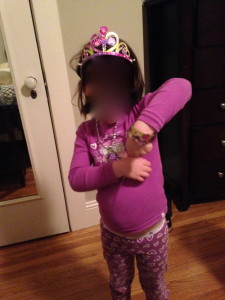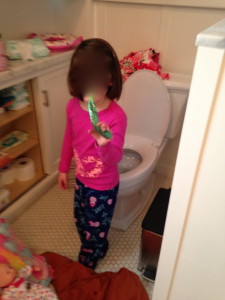At the end of December (new year’s eve) Dr Daum (www.doctordaum.com) began consulting by telephone with a mother in California about her 4‑year old daughter. Within just a few days, her daughter was self initiating pooping in the potty and she was able to return to school, free of accidents, after winter break. The mother’s goal was to time her daughter’s bowel movements for 5:00 pm, a time when her daughter would be home from school and all activities. This goal was achieved!
Our California mom shared a few photos with us and has permitted us to share those with you. As you can see in the first photo, the child’s abdomen is large and distended. This picture was taken on day 1 of treatment, prior to the clean out.

Pre-treatment (doctordaum.com)
Typical appearance of child who stool withholds
Note: distended abdomen
Printed with permission
By day 3, the mom had noticed a significant difference in her daughter’s appearance and sent us this photo, exclaiming: “How’s this look for a cleaned out belly??:)”

Post-treatment (doctordaum.com)
Typical appearance of child NOT stool withholding
Note: flat abdomen
Printed with permission
Recognizing that your child is withholding is an important first step in finding an effective solution and preventing the progression to encopresis or soiling. To help you know if your child is withholding, we have listed below the common physical and behavioral signs.
Physical signs of stool withholding
- A distended, swollen abdomen which is sometimes visible in photos of child in a bathing suit
- Increased flatulence or passage of foul smelling gas
- Small amounts of bright red blood around the stool, on the toilet paper, or in the toilet water. This is usually the result of the passage of a hard and/or large stool that has caused a cut in the anal area called a fissure
- Passage at any time of a stool that is large in diameter
- Rapid fullness after eating solids (early satiety)
- Reflux symptoms including nausea, burping, heartburn and regurgitation. Reflux is the result of delayed emptying of the stomach in association with a large colon filled with stool, gas and liquid
Behavioral signs of stool withholding
- Hiding while pooping (often behind furniture, under a table or behind a closed door)
- Posturing including straightening of the legs or crossing of the legs
- Holding onto furniture with buttocks squeezed together and legs straightened
- Holding onto mother’s legs while crying and agitated
- Dancing the “doody dance” ‑because of discomfort and pressure in the rear end, the child gets up on his or her toes and dances around in obvious discomfort
- Pressing the heel of the foot into the anus in an effort to ‘hold in’ stool









